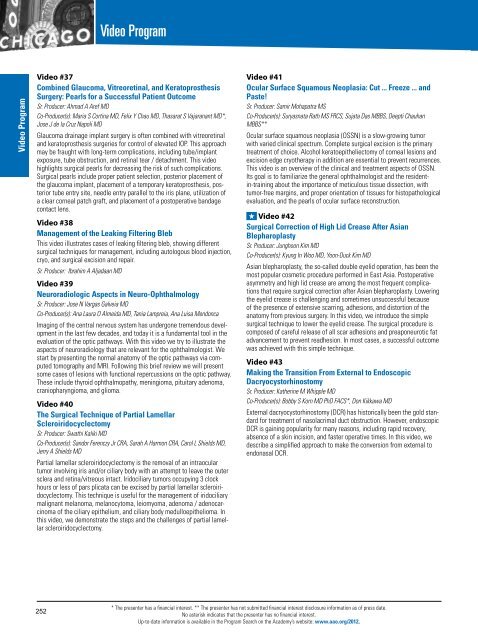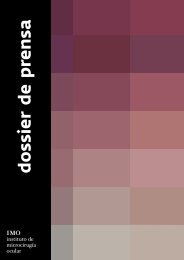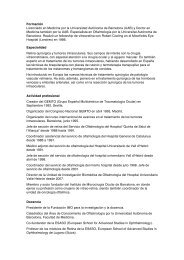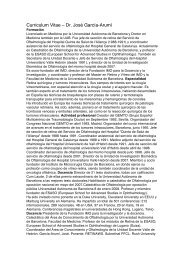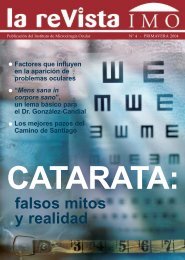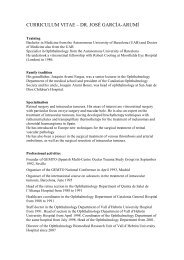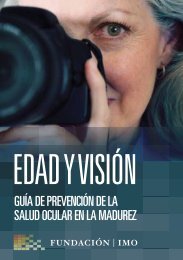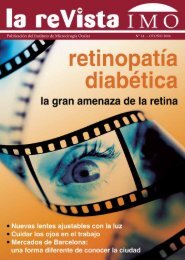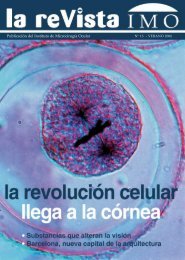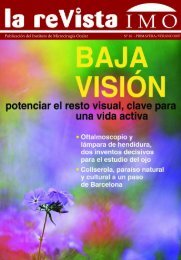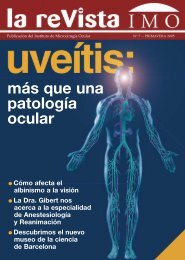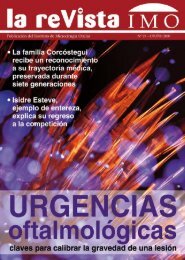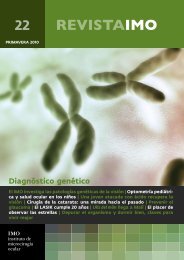FINAL PROGRAM - Imo
FINAL PROGRAM - Imo
FINAL PROGRAM - Imo
Create successful ePaper yourself
Turn your PDF publications into a flip-book with our unique Google optimized e-Paper software.
Video Program<br />
Video Program<br />
Video #37<br />
Combined Glaucoma, Vitreoretinal, and Keratoprosthesis<br />
Surgery: Pearls for a Successful Patient Outcome<br />
Sr. Producer: Ahmad A Aref MD<br />
Co-Producer(s): Maria S Cortina MD, Felix Y Chau MD, Thasarat S Vajaranant MD*,<br />
Jose J de la Cruz Napoli MD<br />
Glaucoma drainage implant surgery is often combined with vitreoretinal<br />
and keratoprosthesis surgeries for control of elevated IOP. This approach<br />
may be fraught with long-term complications, including tube/implant<br />
exposure, tube obstruction, and retinal tear / detachment. This video<br />
highlights surgical pearls for decreasing the risk of such complications.<br />
Surgical pearls include proper patient selection, posterior placement of<br />
the glaucoma implant, placement of a temporary keratoprosthesis, posterior<br />
tube entry site, needle entry parallel to the iris plane, utilization of<br />
a clear corneal patch graft, and placement of a postoperative bandage<br />
contact lens.<br />
Video #38<br />
Management of the Leaking Filtering Bleb<br />
This video illustrates cases of leaking filtering bleb, showing different<br />
surgical techniques for management, including autologous blood injection,<br />
cryo, and surgical excision and repair.<br />
Sr. Producer: Ibrahim A Aljadaan MD<br />
Video #39<br />
Neuroradiologic Aspects in Neuro-Ophthalmology<br />
Sr. Producer: Jose N Vargas Galveia MD<br />
Co-Producer(s): Ana Laura O Almeida MD, Tania Lampreia, Ana Luisa Mendonca<br />
Imaging of the central nervous system has undergone tremendous development<br />
in the last few decades, and today it is a fundamental tool in the<br />
evaluation of the optic pathways. With this video we try to illustrate the<br />
aspects of neuroradiology that are relevant for the ophthalmologist. We<br />
start by presenting the normal anatomy of the optic pathways via computed<br />
tomography and MRI. Following this brief review we will present<br />
some cases of lesions with functional repercussions on the optic pathway.<br />
These include thyroid ophthalmopathy, meningioma, pituitary adenoma,<br />
craniopharyngioma, and glioma.<br />
Video #40<br />
The Surgical Technique of Partial Lamellar<br />
Scleroiridocyclectomy<br />
Sr. Producer: Swathi Kaliki MD<br />
Co-Producer(s): Sandor Ferenczy Jr CRA, Sarah A Harmon CRA, Carol L Shields MD,<br />
Jerry A Shields MD<br />
Partial lamellar scleroiridocyclectomy is the removal of an intraocular<br />
tumor involving iris and/or ciliary body with an attempt to leave the outer<br />
sclera and retina/vitreous intact. Iridociliary tumors occupying 3 clock<br />
hours or less of pars plicata can be excised by partial lamellar scleroiridocyclectomy.<br />
This technique is useful for the management of iridociliary<br />
malignant melanoma, melanocytoma, leiomyoma, adenoma / adenocarcinoma<br />
of the ciliary epithelium, and ciliary body medulloepithelioma. In<br />
this video, we demonstrate the steps and the challenges of partial lamellar<br />
scleroiridocyclectomy.<br />
Video #41<br />
Ocular Surface Squamous Neoplasia: Cut ... Freeze ... and<br />
Paste!<br />
Sr. Producer: Samir Mohapatra MS<br />
Co-Producer(s): Suryasnata Rath MS FRCS, Sujata Das MBBS, Deepti Chauhan<br />
MBBS**<br />
Ocular surface squamous neoplasia (OSSN) is a slow-growing tumor<br />
with varied clinical spectrum. Complete surgical excision is the primary<br />
treatment of choice. Alcohol keratoepitheliectomy of corneal lesions and<br />
excision edge cryotherapy in addition are essential to prevent recurrences.<br />
This video is an overview of the clinical and treatment aspects of OSSN.<br />
Its goal is to familiarize the general ophthalmologist and the residentin-training<br />
about the importance of meticulous tissue dissection, with<br />
tumor-free margins, and proper orientation of tissues for histopathological<br />
evaluation, and the pearls of ocular surface reconstruction.<br />
h Video #42<br />
Surgical Correction of High Lid Crease After Asian<br />
Blepharoplasty<br />
Sr. Producer: Junghoon Kim MD<br />
Co-Producer(s): Kyung In Woo MD, Yoon-Duck Kim MD<br />
Asian blepharoplasty, the so-called double eyelid operation, has been the<br />
most popular cosmetic procedure performed in East Asia. Postoperative<br />
asymmetry and high lid crease are among the most frequent complications<br />
that require surgical correction after Asian blepharoplasty. Lowering<br />
the eyelid crease is challenging and sometimes unsuccessful because<br />
of the presence of extensive scarring, adhesions, and distortion of the<br />
anatomy from previous surgery. In this video, we introduce the simple<br />
surgical technique to lower the eyelid crease. The surgical procedure is<br />
composed of careful release of all scar adhesions and preaponeurotic fat<br />
advancement to prevent readhesion. In most cases, a successful outcome<br />
was achieved with this simple technique.<br />
Video #43<br />
Making the Transition From External to Endoscopic<br />
Dacryocystorhinostomy<br />
Sr. Producer: Katherine M Whipple MD<br />
Co-Producer(s): Bobby S Korn MD PhD FACS*, Don Kikkawa MD<br />
External dacryocystorhinostomy (DCR) has historically been the gold standard<br />
for treatment of nasolacrimal duct obstruction. However, endoscopic<br />
DCR is gaining popularity for many reasons, including rapid recovery,<br />
absence of a skin incision, and faster operative times. In this video, we<br />
describe a simplified approach to make the conversion from external to<br />
endonasal DCR.<br />
252<br />
* The presenter has a financial interest. ** The presenter has not submitted financial interest disclosure information as of press date.<br />
No asterisk indicates that the presenter has no financial interest.<br />
Up-to-date information is available in the Program Search on the Academy’s website: www.aao.org/2012.


